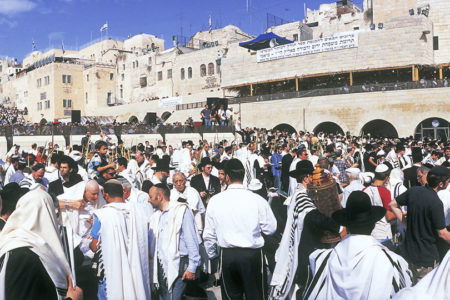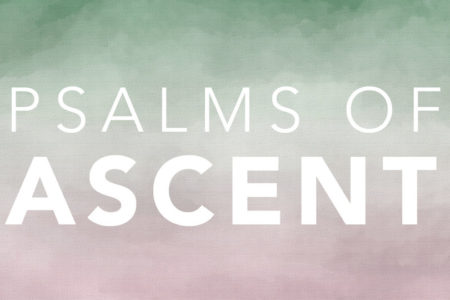The Feasts of Tabernacles in the Days of Jesus
The Feast of Tabernacles during the time of Jesus was full of pageantry fueled with great expectation.
It was the “season of our rejoicing” because Jewish people believed the promise of the Messianic Kingdom actually could be fulfilled during this time. The Feast of Tabernacles, or Sukkot, marked the end of the religious calendar year that started in the spring with Passover. God’s grand work, which began with Passover and its redemption story, culminated with Sukkot and its theme of restoration. It was the seventh and final God ordained observance as recorded in Leviticus 23. It was also the third and final annual feast that required Jewish men to make a pilgrimage to Jerusalem (Dt. 16:16).
In Bible times, Sukkot was fascinating. God commanded the people to build sukkot (plural of sukkah), which were temporary booths. Then they were to gather at the sanctuary for a jubilant, seven-day celebration. The first day and the eighth, which was added at the end of the week, were considered Sabbaths. At the Temple, priests scurried around the Great Altar, offering special sacrifices (Lev. 23:33–43; Num. 29:12–38).
It was at His final Tabernacle celebration while on Earth that Jesus offered to fulfill the anticipated yearnings of many hearts on the Feast day: He offered refreshment (Jn. 7:37), rejoicing (Jn. 8:12), and rest (Jn. 9:14).
Refreshment
Caravans of pilgrims from faraway lands made aliyah (went up) to Jerusalem. Filled with thanksgiving, gladness, and expectancy, these pilgrims cheerfully shouted praises to God as they sang the songs of aliyah: Psalms 120—134.
Arriving at the City of God, some went to the homes of friends and relatives while others gratefully accepted the hospitality of strangers. The rest pitched camp all around the city. First they erected their sukkot, similar to the type farmers lived in during the annual grape and olive harvests. They constructed them from willow and olive branches and decorated them with grapevines and fruit. They could find these items in the Kidron Valley just east of the city. The sukkot were built to be sturdy and shady. Choice locations were rooftops, courtyards, and streets. Inside, comfortable cushions for reclining were placed around a triclinium— a low, three-sided table.
Only elegant bowls and cups were used during mealtime. Oil lamps provided the necessary light.
Each lulav was then assembled by tying together a palm, myrtle, and willow branch. A local Jerusalem custom was to tie them using a golden thread. Pilgrims carried their fragrant lulavs in their right hands and a lemon-like citrus fruit in their left. At the appropriate time, they waved these before the Lord in a spirit of thankfulness.
A water-drawing ritual began the festivities every morning. Standing at the top southwest corner of the Temple Mount, a priest blew the shofar (ram’s horn) with all his might, announcing the start of the festival. Suddenly a priest exited from the Water Gate on the south side of the main Temple building. Carrying a golden pitcher, he led a joyous musical procession to the Pool of Siloam in the old City of David. At the pool, he plunged the pitcher into the water and recited, “Therefore, with joy shall ye draw water out of the wells of salvation” (Isa. 12:3). Accompanying the chant was the sweet sound of an instrument called the reed flute of Moses. Moses means “to draw out.” (Pharoah’s daughter named him that because she drew him out of the water [Ex. 2:10].)
Jerusalem’s sole water supply was from this pool and the Gihon Spring that feeds it. Therefore, the water was precious. It was a source of life and refreshment. When people asked why the ritual was called “the drawing out of water,” they were told, “because of the pouring out of the Ruach Ha-Kodesh [Holy Spirit].” The water symbolized the Holy Spirit, the only true source of life. After the Temple was destroyed, the rabbis reflected on this celebration and said, “He who has not seen the rejoicing at the place of the waterdrawing has never seen rejoicing in his life” (Talmud Sukkah 51b).
The priest returned to the Temple with the golden pitcher of water and joined another priest who was carrying the drink offering of wine. The shofar was blown three times. Together the two priests ascended the ramp to the Great Altar and poured their libations into silver funnels. During this ritual, the people gathered at the Temple’s Court of the Women and sang praises called the Hallel: Psalms 113—118. The Levites, standing on the 15 semicircular stairs in the court, also sang and played musical instruments. The mixture of the water and wine at the altar symbolized the life and joy associated with the Holy Spirit. About now, several priests holding willow branches marched once around the Great Altar, reciting for all to hear, “Save now (hoshanah), I beseech thee, O LORD! O LORD, I beseech thee, send now prosperity!” (Ps. 118:25).
Following the singing and chanting, a great silence descended on the sanctuary. The people felt and listened to the wind, reflecting on the spiritual significance of the water ritual. They were expressing a desire for personal, spiritual refreshment. Only God’s Spirit, symbolized by the water, could satisfy their thirsty souls. Finally, a benediction closed the celebration and all went home to gather under their sukkot.
The water ritual took place every day for all seven days. On the seventh day, it took on an intensity filled with excitement and anticipation. This last day of the Feast was Hoshanah Rabbah (the Great Praise Day). And it was then that an extraordinary incident took place.
Perhaps Jesus was seated near the Water Gate or somewhere in the Court of the Women, watching the final drama of the water ritual. And, at the very moment when the customary hush came over the crowd, perhaps it was then He “stood and cried out, saying, If any man thirst, let him come unto me, and drink” (Jn. 7:37). He was inviting the multitude to receive the Holy Spirit. They could find their anticipated refreshment by accepting Him as the true Living Water (Jn. 4:10). Even today, His invitation is still genuine: “Come unto me.”
Rejoicing
A second fascinating ceremony associated with the Feast of Tabernacles involved lights. Each afternoon of the seven days, priests and pilgrims gathered at the Court of the Women. Four large oil lamps illuminated the court. It was said that the light from these lamps was so bright it penetrated every courtyard in Jerusalem.
As the women watched from the upper terraces, the “men of piety and good works used to dance before the oil lamps with burning torches in their hands, singing songs and praises.” Meanwhile, “countless levites played on harps, lyres, cymbals and trumpets and instruments of music” (Mishnah Sukkot 5:4). The light festivities continued all night until dawn.
The illumination from these imposing Temple lamps symbolized two realities. The first was the reality of the “Light of all Lights”— the Shekinah Glory—the visible presence of God that filled the first Temple, which Solomon built (1 Ki. 8:10–11). The second was Ha’or Gadol (the Great Light) who would soon come and bring light to those who were spiritually dead and dwelling in darkness (Isa. 9:2).
Jesus was at the Temple. Perhaps it was during the light celebration or when the lights were extinguished on the eighth day that He said for all to hear, “I am the light of the world; he that followeth me shall not walk in darkness, but shall have the light of life” (Jn. 8:12). He proclaimed two truths with this statement: (1) He is the “Great Light” who the prophet Isaiah said would come, and (2) He is God in the flesh and the Glory of the Temple (cf. Jn. 1:14).
The response was threefold. Some religious people rejected Him (Jn. 8:13), others were inquisitive enough to ask Him for more information (Jn. 8:25), and still others believed and received him (Jn. 8:30). The joy associated with the lights and water rituals of the Feast of Tabernacles anticipated Jesus’ coming and bringing light and life to a dark, sinful world.
Rest
In ancient times, the eighth day of the Feast of Tabernacles was called the “Last Good Day.” Viewed as a Sabbath, it was designed as a time to rest and reflect on the spiritual significance of the seven-day jubilation. Special activities took place at the Temple. The priests offered the daily and special Sabbath sacrifices (Num. 28:9–10), while others recited Psalm 92, the Sabbath song anticipating the blessings of the Messianic Kingdom. Lingering in the minds and hearts of everyone during the entire weeklong celebration was, no doubt, the expectation that, at any moment, God could establish the great Sukkah Shalom (Tabernacle of Peace).
“For thou, LORD, hast made me glad through thy work; I will triumph in the works of thy hands” (Ps. 92:4). When the festivities had all ceased, Jesus again came to the Temple—this time to perform an awesome work with His hands. He gave sight to a man born blind (Jn. 9). Everyone knew this kind of miracle required divine intervention. After anointing the man’s eyes with clay from the ground, Jesus instructed him, ”Go, wash in the pool of Siloam (which is by interpretation, Sent). He [the blind man] went his way, therefore, and washed, and came seeing” (v. 7).
Jesus sent the blind man to the same pool the priest with the golden pitcher had fetched water from each day of the Feast. Jesus was teaching that it is the Holy Spirit, represented by water and whom He alone can give, who can open the eyes of all who are spiritually blind. The text also states, “And it was the sabbath day when Jesus made the clay, and opened his eyes” (v. 14).
Jesus performed this miracle to validate everything He had said and done during the Feast of Tabernacles. By doing the impossible, He proved His words could be trusted and that He was God in the flesh, the Messiah of Israel, the true dispenser of the Holy Spirit, and the only source of light and life. Mankind no longer has to fumble blindly in this world. True rest for the wanderer is available in Jesus Christ.
The hopes of the “Last Good Day” culminated with an event that happened six months later. It was Passover, when Jesus died as the Lamb of God. His shed blood, death, and resurrection make the expectation of personal refreshment (Jn. 7:37), rejoicing (Jn. 8:12), and rest (Jn. 9:14), as anticipated at the Feast of Tabernacles, a reality for all who accept.






Thankful to find this description.
very helpful
thank you
Thanks
So much to comprehend Thanks
Your article adds another most significant dimension to my understanding of why Jesus did what he did in John Chapter 7 and 8. Very helpful indeed. Thank you.